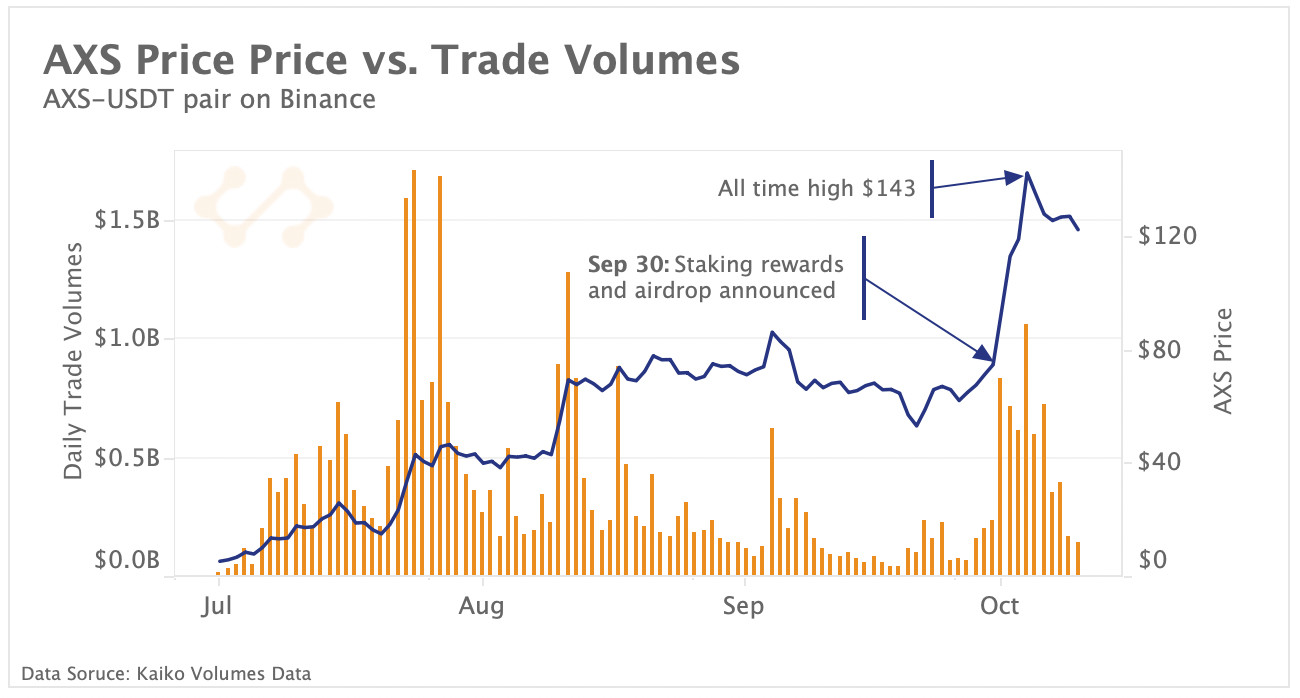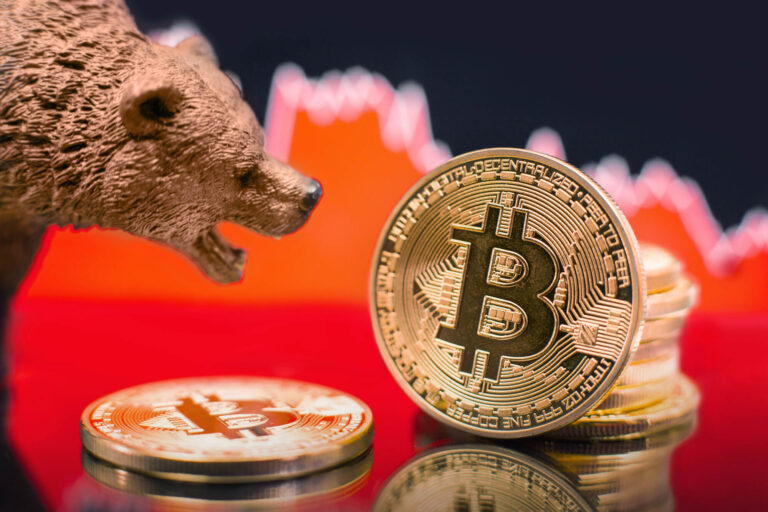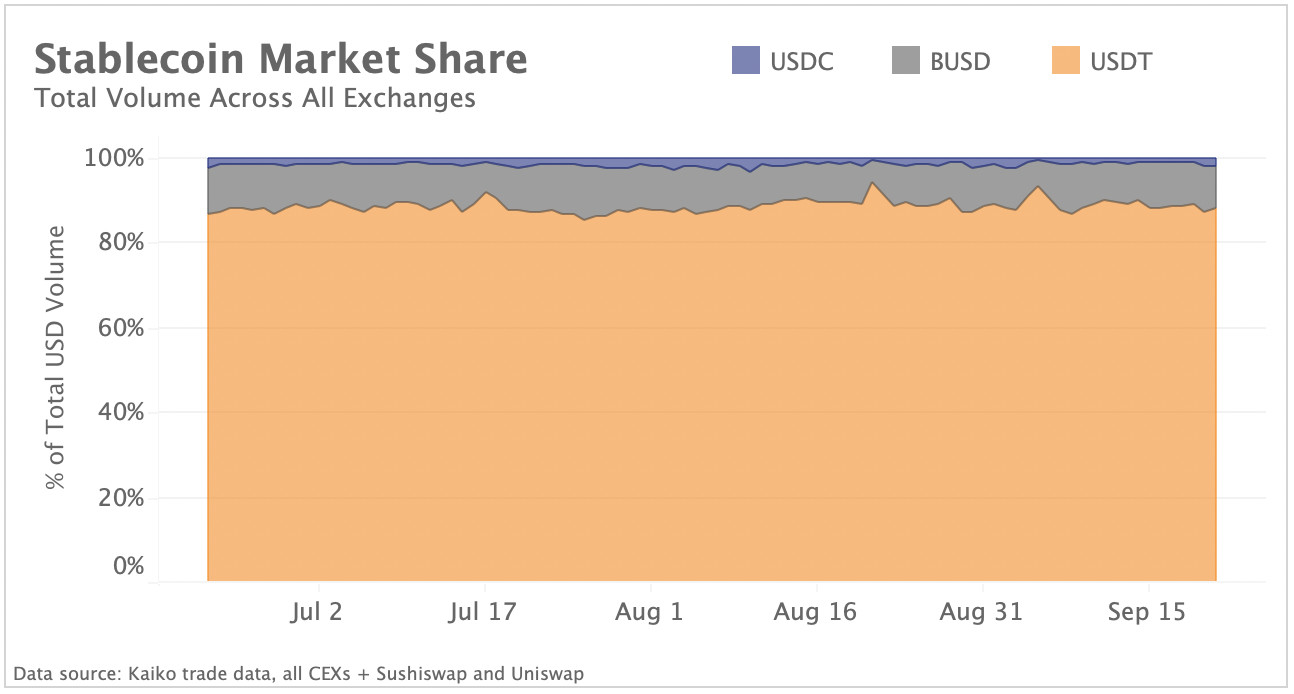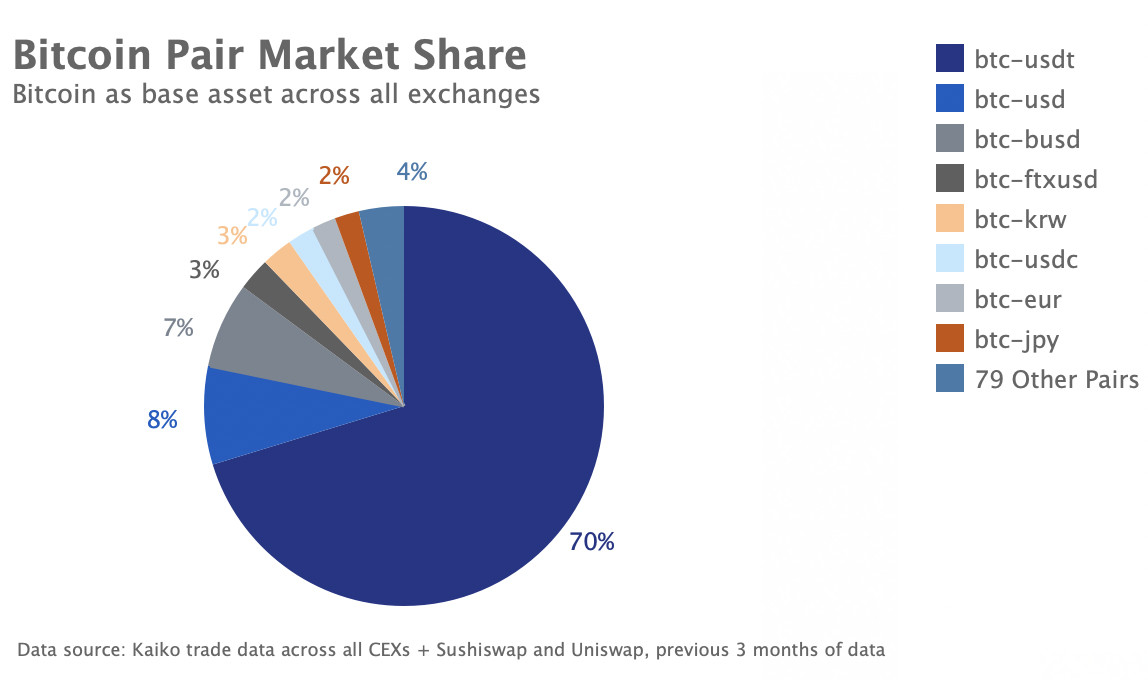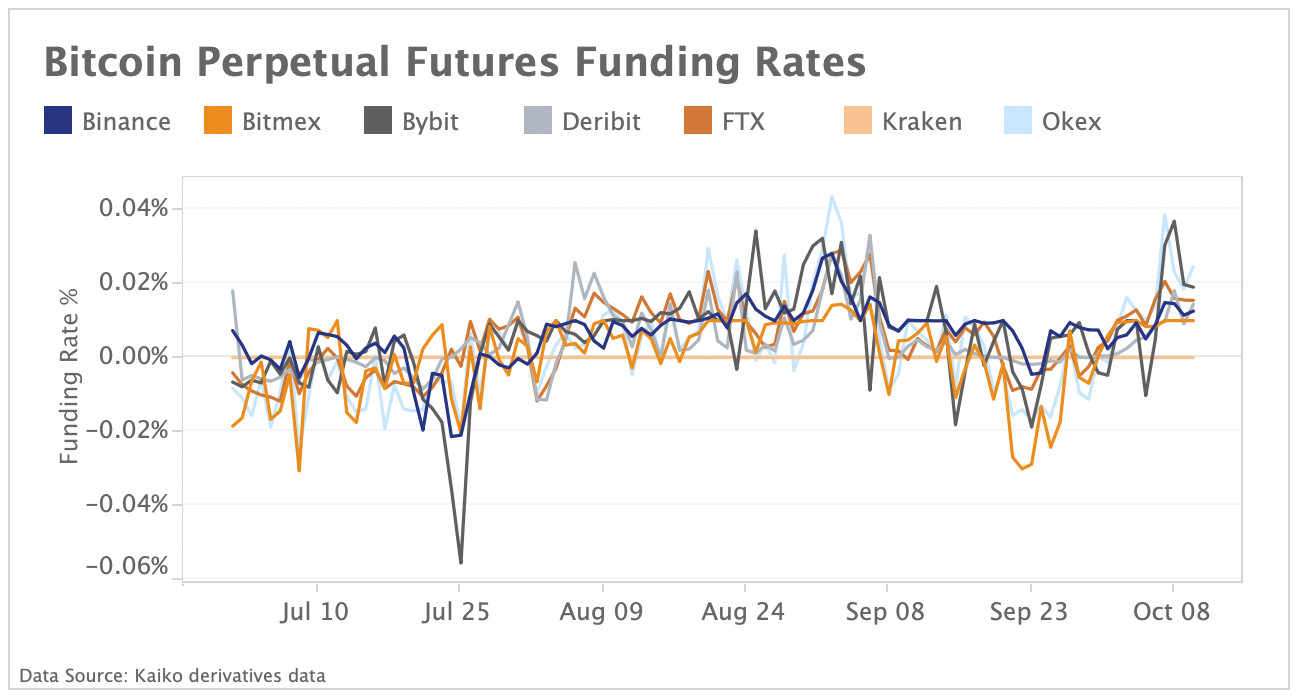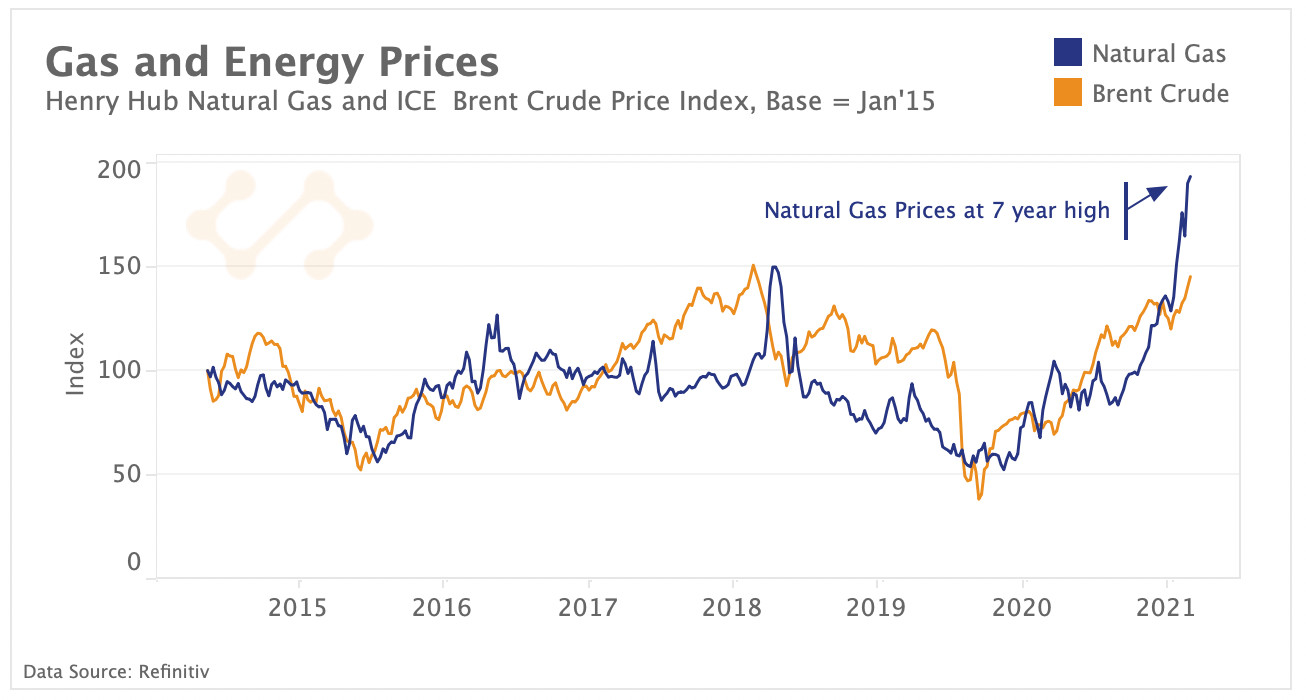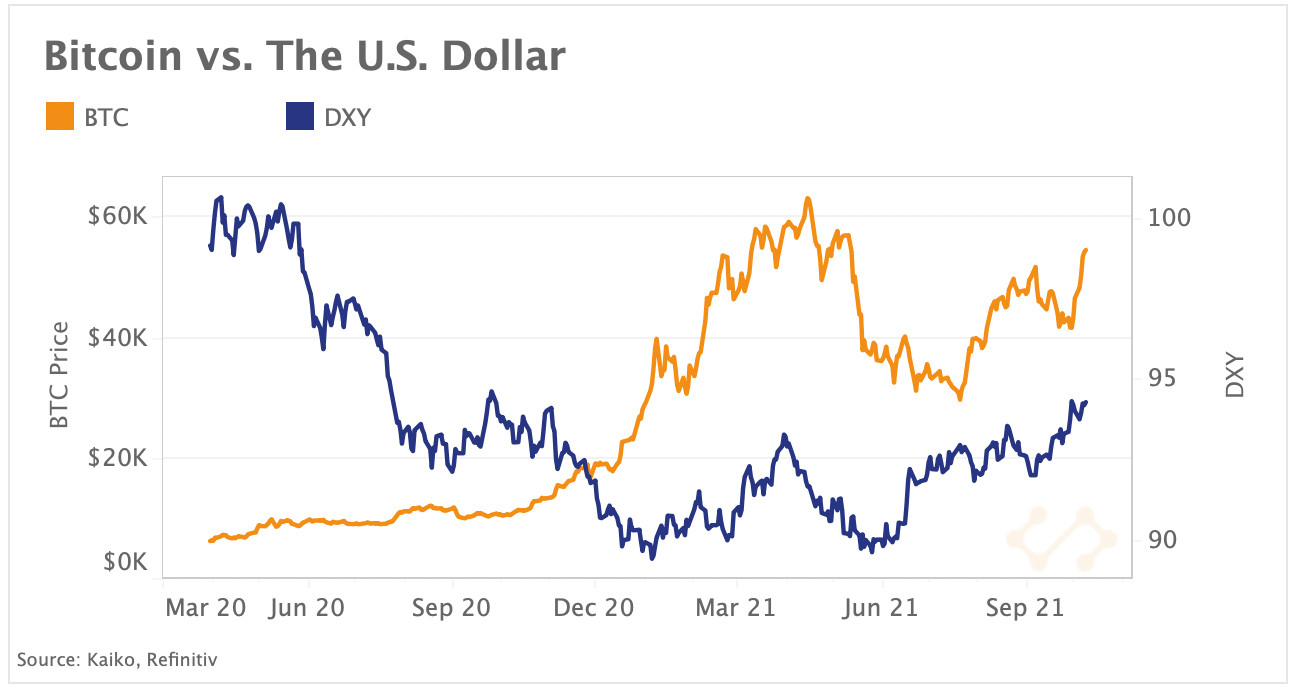A summarizing review of what has been happening at the crypto markets of the past week. A look at trending sectors, liquidity, volatility, spreads and more. The weekly report in cooperation with market data provider Kaiko.
The last 7 days in cryptocurrency markets:
- Price Movements: The native tokens for Layer 2 scaling solutions have seen strong returns since July.
- Volume Dynamics: Nearly half of all Bitcoin trades are executed using Tether.
- Order Book Liquidity: Average price slippage for large market orders fluctuates throughout the day on Binance and Coinbase.
- Derivatives: Positive funding rates and rising open interest suggest crypto markets have flipped bullish.
- Macro Trends: Bitcoin's inverse correlation with the U.S. Dollar Index has largely dissipated in 2021.
Bitcoin leads crypto market momentum
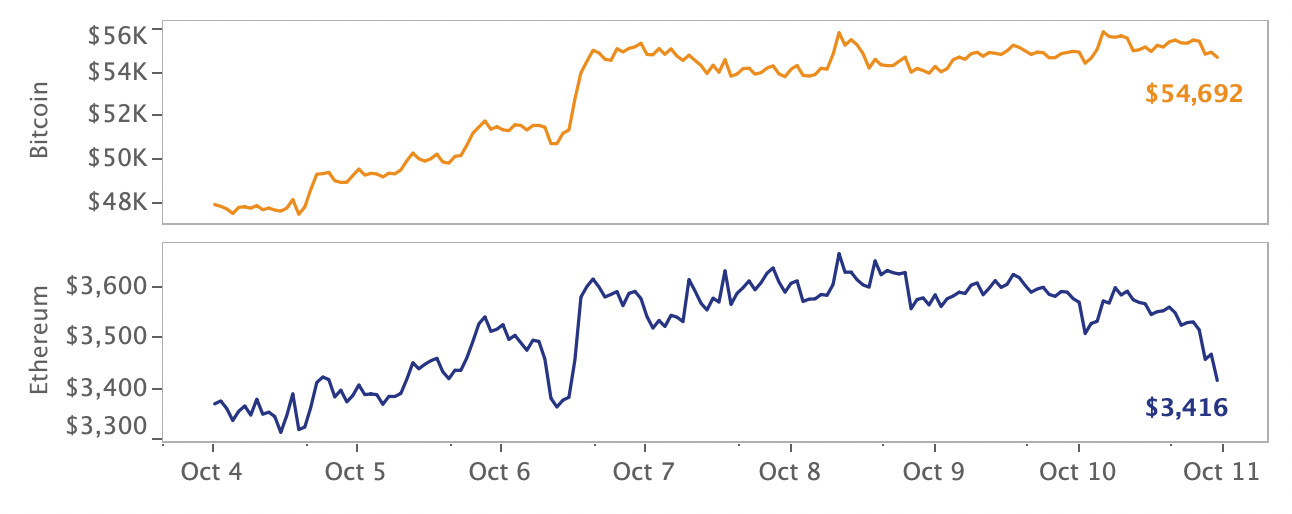
Bitcoin broke above $56K for the first time since May, leading the “Uptober” crypto rally and largely outperforming most altcoins. What's caused the recent surge? On the regulatory front, the U.S. Fed Chair Jerome Powell reassured investors that the central bank has no plans to ban crypto. Institutional interest also spiked on mounting speculation that the U.S. Securities and Exchange Commission (SEC) will approve a Bitcoin ETF in the coming months. Bitcoin futures contracts on the Chicago Mercantile Exchange (CME) traded at their highest premium against spot since mid-April, suggesting rising institutional demand for crypto exposure. The crypto rally comes in stark contrast to traditional markets, which have trended downwards amid rising energy inflation and signs of a slowdown in growth.
AXS prices catapult on staking announcement
Axie Infinity, one of the fastest growing play-to-earn games based on blockchain technology, has seen frenzied-levels of interest over the past few months. Last week, the company closed a $150 million Series B round at a $3 billion valuation and its in-game AXS token has surged 1250% over the last quarter. Above, we chart AXS price vs. trade volume on Binance and can observe that prices climbed parabolically following the company's announcement that they would airdrop $60 million to the game's early adopters and would enable AXS staking. Prices have since broken all time highs of $143 as trade volumes surged past $1 billion. It is interesting to note, however, that volumes are not nearly as high as late-August, during the peak of the NFT-platform bull run.
Layer 2 scaling solutions take off in 2021
The exponential growth of DeFi and NFT ecosystems have led to rising transaction fees and congestion on the Ethereum network. To remain competitive, many projects have turned to Layer 2 solutions which promise to scale the Ethereum mainnet by executing thousands of transactions per second off-chain before settling the final balance on the base layer. Over the past few weeks, the total value locked on Layer 2 scaling solutions more than tripled to $3.1bn, according to ecosystem tracker L2Beat, boosted by the launch of several long-awaited scaling projects including Arbitrum and Optimism.
Above, we chart the returns of layer 2 native tokens since the start of the third quarter and we observe that OMG Network’s token OMG has registered the strongest growth (+226%). OMG is a decentralized payment network that allows high-throughput, low fee, peer-to-peer transactions. Polygon Network, another scaling solution, has grown significantly since the start of the year and recently flipped the Ethereum network in terms of number of active addresses. However, its native token MATIC has lost some steam over the past few months, rising by a meager 19% since July, although the project is still up more than 7,000% YTD.
Tether faces growing scrutiny
Stablecoins have had a tough few weeks as U.S. regulators, politicians, and journalists ramp up public scrutiny. Last week, Bloomberg published an in-depth article exploring the mysterious make-up of Tether's reserves in the context of its $69 billion market cap, which would technically rank it within the top 50 U.S. banks. The top three stablecoins by market cap today are Tether (USDT), Circle's USDC (market cap of $33 billion) and Binance's BUSD (market cap of $13 billion).
Collectively, daily trade volumes for the three stablecoins average between $80-$100 billion every day. While both USDC and USDT have faced their fare share of scrutiny, USDT still accounts for the vast majority of market share when analyzing actual trade volume executed using each stablecoin. Below, we chart the market share of volume across all exchanges for USDT, USDC, and BUSD:
We can observe that today, more than 85% of all trades using a stablecoin are executed using Tether vs. the other top stablecoins. BUSD accounts for around 10% of market share of volume and USDC 2%. When analyzing the breakdown in total Bitcoin volume for all pairs of which Bitcoin is the base asset, we can observe a similar trend. The vast majority of trades for Bitcoin are executed using Tether as the denominating currency.
The top three Bitcoin pairs are BTC-USDT, BTC-USD and BTC-BUSD, although the second ranking pair (BTC-USD) only accounts for 8% of total volume, compared with 70% for BTC-USDT. When looking at the market share of volume for all pairs of which Bitcoin is either the base or quote, Tether's dominance falls slightly to 49%. The ETH-BTC pair ranks second for a total of 13% of market share. All pairs with less than 1% of total volume are grouped together, accounting for 1,000+ other pairs.
Open interest rises as markets flip bullish
Open interest for Bitcoin perepetual futures surged last week as Bitcoin's price crossed the $55k mark and speculation mounted that the approval of a Bitcoin ETF by the SEC is imminent. Ethereum open interest increased slightly to $4.4b, although remains just half that of Bitcoin ($9.9b). Bitcoin's sharp price increase last week could be linked to perpetual futures markets, which saw a rapid increase in trade volumes immediately preceding the surge.
Funding rates also increased to one month highs last week, which is a sign that longs outweigh shorts. The funding rate is the mechanism that pegs the perpetual future price to the spot price. When investors are bullish on an asset, they accumulate long perpetual futures positions which can cause the contract to trade at a premium to spot prices. Funding rates will turn positive, signifying that long holders need to pay shorts, which should incentivize shorting and an eventual convergence between the perpetual futures contract and the underlying spot.
Funding rates were highest on Okex and Bybit, two derivatives exchanges which are based in Asia and have historically had ties to China. There are also bullish signs on regulated derivatives platform CME, with the front-month Bitcoin futures contract trading at a 12% premium vs. spot prices.
Rising energy costs fuel inflation fears
Energy costs have surged to 7-year highs over the past few weeks driven by rising demand and supply constraints. Oil prices are up 20% since August while gas prices have surged more than 60%. This has fueled fears that inflation could be more persistent than anticipated as rising energy prices could increase firms’ production costs. This could force the U.S. central bank to tighten more abruptly its monetary policy which could negatively impact risk-on assets such as equities and crypto. However, Bitcoin has historically been viewed as a hedge against inflation and has a loose correlation to inflation expectations. Rising inflation and energy prices could benefit the crypto asset should investors seek a safe haven.
Bitcoin no longer holds an inverse correlation with the U.S. Dollar
The Dollar Index (DXY), which measures the performance of the greenback against a basket of foreign currencies, edged up 0.3% last week despite lower than expected U.S. payroll data. The Dollar strengthened in September for a second month in a row as investors feared a slowdown in China's growth and rising energy inflation. Historically, Bitcoin has moved in the opposite direction to the DXY. However, this trend seems to have largely dissipated in 2021, with both now on an upward trajectory in contrast to traditional equities, which closed September with their worst performance since the start of the pandemic. Bitcoin's rising correlation with the DXY suggests that despite a growing risk-off environment, both fiat and crypto assets are treated similarly by investors.


